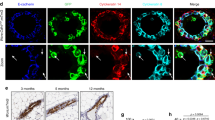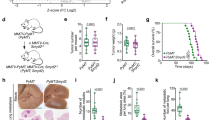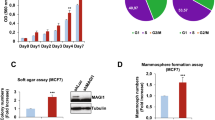Abstract
Suppression of tropomyosins (TMs), a family of actin-binding, microfilament-associated proteins, is a prominent feature of many transformed cells. Yet it is unclear whether downregulation of TMs occur in human tumors. We have investigated the expression of tropomyosin-1 (TM1) in human breast carcinoma tissues by in situ hybridization and immunofluorescence. TM1 mRNA and protein are readily detectable in normal mammary tissue. In contrast, TM1 expression is abolished in the primary human breast tumors. Expression of other TM isoforms, however, is variable among the tumors. The consistent and profound downregulation of TM1 suggests that TM1 may be a novel and useful biomarker of mammary neoplasms. These data also support the hypothesis that suppression of TM1 expression during the malignant conversion of mammary epithelium as a contributing factor of breast cancer. In support of this hypothesis, we show that the ability to suppress malignant growth properties of breast cancer cells is specific to TM1 isoform. Investigations into the mechanisms of TM1-induced tumor suppression reveal that TM1 induces anoikis (detachment induced apoptosis) in breast cancer cells. Downregulation of TM1 in breast tumors may destabilize microfilament architecture and confer resistance to anoikis, which facilitates survival of neoplastic cells outside the normal microenvironment and promote malignant growth.
This is a preview of subscription content, access via your institution
Access options
Subscribe to this journal
Receive 50 print issues and online access
$259.00 per year
only $5.18 per issue
Buy this article
- Purchase on Springer Link
- Instant access to full article PDF
Prices may be subject to local taxes which are calculated during checkout






Similar content being viewed by others
References
Ahram M, Best CJ, Flaig MJ, Gillespie JW, Leiva IM, Chuaqui RF, Zhou G, Shu H, Duray PH, Linehan WM, Raffeld M, Ornstein DK, Zhao Y, Petricoin III EF and Emmert-Buck MR . (2002). Mol. Carcinog., 33, 9–15.
Asch HL, Head K, Dong Y, Natoli F, Winston JS, Connolly JL and Asch BB . (1996). Cancer Res., 56, 4841–4845.
Beckmann MW, Niederacher D, Schnurch HG, Gusterson BA and Bender HG . (1997). J. Mol. Med., 75, 429–439.
Bharadwaj S and Prasad GL . (2002). Cancer Lett., 183, 205–213.
Bhattacharya B, Prasad GL, Valverius EM, Salomon DS and Cooper HL . (1990). Cancer Res., 50, 2105–2112.
Braverman RH, Cooper HL, Lee HS and Prasad GL . (1996). Oncogene, 13, 537–545.
Coll ML, Rosen K, Ladeda V and Filmus J . (2002). Oncogene, 21, 2908–2913.
Cooper HL, Feuerstein N, Noda M and Bassin RH . (1985). Mol. Cell. Biol., 5, 972–983.
Coulier F, Martin-Zanca D, Ernst M and Barbacid M . (1989). Mol. Apoptosis, Cell. Biol., 9, 15–23.
Darzynkiewicz Z, KLi X and Bedner E . (2001). Methods Cell Biol. Vol. 66. Schawartz LM and Ashwell JD (eds). Academic Press: San Diego, pp. 69–109.
Dhar S, Bhargava R, Yunes M, Li B, Goyal J, Naber SP, Wazer DE and Band V . (2001). Clin. Cancer Res., 7, 3393–3398.
Donner K, Ollikainen M, Ridanpaa M, Christen HJ, Goebel HH, de Visser M, Pelin K and Wallgren-Pettersson C . (2002). Neuromuscular Disorders, 12, 151–158.
Fearon ER and Vogelstein B . (1990). Cell, 61, 759–767.
Ferguson AT, Evron E, Umbricht CB, Pandita TK, Chan TA, Hermeking H, Marks JR, Lambers AR, Futreal PA, Stampfer MR and Sukumar S . (2000). Proc. Natl. Acad. Sci. USA, 97, 6049–6054.
Franzen B, Linder S, Alaiya AA, Eriksson E, Fujioka K, Bergman AC, Jornvall H and Auer G . (1997). Electrophoresis, 18, 582–587.
Franzen B, Linder S, Uryu K, Alaiya AA, Hirano T, Kato H and Auer G . (1996). Br. J. Cancer, 73, 909–913.
Frisch SM and Screaton RA . (2001). Curr. Opin. Cell Biol., 13, 555–562.
He TC, Zhou S, da Costa LT, Yu J, Kinzler KW and Vogelstein B . (1998). Proc. Natl. Acad. Sci. USA, 95, 2509–2514.
Hendricks M and Weintraub H . (1981). Proc. Natl. Acad. Sci. USA, 78, 5633–5637.
Janssen RA and Mier JW . (1997). Mol. Biol. Cell, 8, 897–908.
Li B, Goyal J, Dhar S, Dimri G, Evron E, Sukumar S, Wazer DE and Band V . (2001). Cancer Res., 61, 8014–8021.
Lin JJ, Warren KS, Wamboldt DD, Wang T and Lin JL . (1997). Intl. Rev. Cytol., 170, 1–38.
Lin JL, Geng X, Bhattacharya SD, Yu JR, Reiter RS, Sastri B, Glazier KD, Mirza ZK, Wang KK, Amenta PS, Das KM and Lin JJ . (2002). Gastroenterology, 123, 152–162.
Lu Y, Lin YZ, LaPushin R, Cuevas B, Fang X, Yu SX, Davies MA, Khan H, Furui T, Mao M, Zinner R, Hung MC, Steck P, Siminovitch K and Mills GB . (1999). Oncogene, 18, 7034–7045.
Mahadev K, Raval G, Bharadwaj S, Willingham MC, Lange EM, Vonderhaar B, Salomon D and Prasad GL . (2002). Exp. Cell Res., 279, 40–51.
Matsumura F, Lin JJ, Yamashiro-Matsumura S, Thomas GP and Topp WC . (1983). J. Biol. Chem., 258, 13954–13964.
Meech SJ, McGavran L, Odom LF, Liang X, Meltesen L, Gump J, Wei Q, Carlsen S and Hunger SP . (2001). Blood, 98, 1209–1216.
Michele DE and Metzger JM . (2000). J. Mol. Med., 78, 543–553.
Mielnicki LM, Ying AM, Head KL, Asch HL and Asch BB . (1999). Exp. Cell Res., 249, 161–176.
Mitra G, Martin-Zanca D and Barbacid M . (1987). Proc. Natl. Acad. Sci. USA, 84, 6707–6711.
Mondy JS, Lindner V, Miyashiro JK, Berk BC, Dean RH and Geary RL . (1997). Circ. Res., 81, 320–327.
Nass SJ, Herman JG, Gabrielson E, Iversen PW, Parl FF, Davidson NE and Graff JR . (2000). Cancer Res., 60, 4346–4348.
Pawlak G and Helfman DM . (2001). Curr. Opin. Gen. Dev., 11, 41–47.
Persad S, Attwell S, Gray V, Delcommenne M, Troussard A, Sanghera J and Dedhar S . (2000). Proc. Natl. Acad. Sci. USA, 97, 3207–3212.
Pittenger MF, Kazzaz JA and Helfman DM . (1994). Curr. Opin. Cell Biol., 6, 96–104.
Prasad GL, Fuldner RA and Cooper HL . (1993). Proc. Natl. Acad. Sci. USA, 90, 7039–7043.
Prasad GL, Masuelli L, Raj MH and Harindranath N . (1999). Oncogene, 18, 2027–2031.
Prasad GL, Meissner PS, Sheer D and Cooper HL . (1991). Biochem. Biophys. Res. Commun., 177, 1068–1075.
Prasad GL, Valverius EM, McDuffie E and Cooper HL . (1992). Cell Growth Differentiation, 3, 507–513.
Shah V, Bharadwaj S, Kaibuchi K and Prasad GL . (2001). Oncogene, 20, 2112–2121.
Shields JM, Mehta H, Pruitt K and Der CJ . (2002). Mol. Cell. Biol., 22, 2304–2317.
Sirchia SM, Ferguson AT, Sironi E, Subramanyan S, Orlandi R, Sukumar S and Sacchi N . (2000). Oncogene, 19, 1556–1563.
Sommers CL, Byers SW, Thompson EW, Torri JA and Gelmann EP . (1994). Breast Cancer Res. Treat., 31, 325–335.
Stupack DG and Cheresh DA . (2002). J. Cell Sci., 115, 3729–3738.
Umbricht CB, Evron E, Gabrielson E, Ferguson A, Marks J and Sukumar S . (2001). Oncogene, 20, 3348–3353.
Wang SC, Makino K, Xia W, Kim JS, Im SA, Peng H, Mok SC, Singletary SE and Hung MC . (2001). Oncogene, 20, 6960–6964.
Windham TC, Parikh NU, Siwak DR, Summy JM, McConkey DJ, Kraker AJ and Gallick GE . (2002). Oncogene, 21, 7797–7807.
Xu LH, Yang X, Bradham CA, Brenner DA, Baldwin Jr AS, Craven RJ and Cance WG . (2000). J. Biol. Chem., 275, 30597–30604.
Yang X, Yan L and Davidson NE . (2001). Endocrine-Relat. Cancer, 8, 115–127.
Zhu Z, Sanchez-Sweatman O, Huang X, Wiltrout R, Khokha R, Zhao Q and Gorelik E . (2001). Cancer Res., 61, 1707–1716.
Acknowledgements
This work is supported by grants from the US Department of Defense Breast Cancer Program (DaMD-98-1-8162 and DAMD-991-9395), American Cancer Society (RPG-99-069-01-CSM), NC Biotechnology Center (ARIG 2000-054) and Kulynych Family Funds For Medical Research. We thank Deanna Brown for her help in tissue screening, and Gilda Saluta of the Tumor Bank of Wake Forest University School of Medicine for providing us tissue specimens used in this study. We thank Dr Ethan Lange for his help in statistical analyses, and Dr Vijay Setaluri for the control adeno virus.
Author information
Authors and Affiliations
Corresponding author
Rights and permissions
About this article
Cite this article
Raval, G., Bharadwaj, S., Levine, E. et al. Loss of expression of tropomyosin-1, a novel class II tumor suppressor that induces anoikis, in primary breast tumors. Oncogene 22, 6194–6203 (2003). https://doi.org/10.1038/sj.onc.1206719
Received:
Revised:
Accepted:
Published:
Issue Date:
DOI: https://doi.org/10.1038/sj.onc.1206719
Keywords
This article is cited by
-
Anoikis resistance––protagonists of breast cancer cells survive and metastasize after ECM detachment
Cell Communication and Signaling (2023)
-
Stopping transformed cancer cell growth by rigidity sensing
Nature Materials (2020)
-
Actin–tropomyosin distribution in non-muscle cells
Journal of Muscle Research and Cell Motility (2020)
-
Validation of target proteins of down-regulated miR-221-5p in HeLa cells treated with Polyalthia longifolia leaf extract using label-free quantitative proteomics approaches
3 Biotech (2020)
-
Screening of potential biomarkers for cholangiocarcinoma by integrated analysis of microarray data sets
Cancer Gene Therapy (2016)



